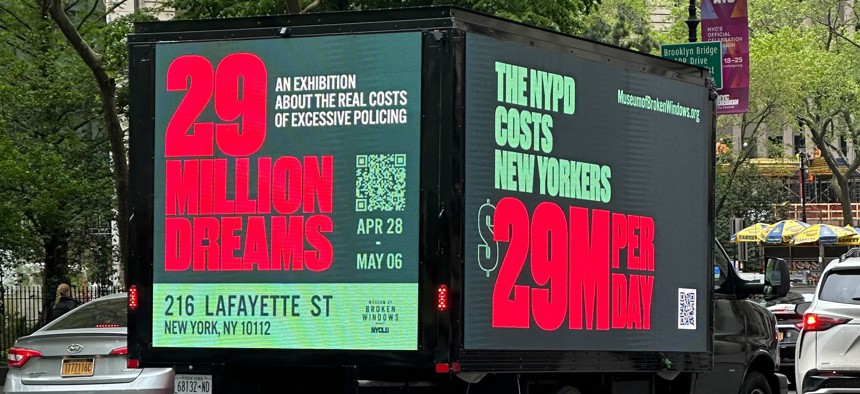With New York City budget negotiations underway, a truck dispatched by the New York Civil Liberties Union brought a message about exorbitant police spending right to officials’ front door as it encircled City Hall on Thursday.
On its own, the jet-black truck would be distinctive, but add in bold lettering, “The NYPD costs New Yorkers $29M per day,” across the billboards on the vehicle’s sides and it’s unmissable. That’s exactly the point. Near the eye-catching words, there’s information that would lead onlookers to a pop-up exhibition called “29 Million Dreams” that opens to the public tomorrow less than a mile from City Hall. Its theme? “Exploring the price that New York pays for overpolicing” and the needs that go unmet when the city spends so much on the NYPD, according to Johanna Miller, director of the NYCLU’s Education Policy Center.
“We picked the location for the museum this year to be pretty close to City Hall specifically in the hopes that lawmakers will come in and engage with the content,” Miller said. “We also want New Yorkers to feel empowered to take action when it comes to city budget time and actually get in touch with the mayor and their City Council person.”
The NYCLU and its partner organization, The Soze Agency, have invited nearly every member of the City Council as well as a handful of state lawmakers to visit the Museum of Broken Windows exhibit, which will be open from April 28 to May 6. As for Mayor Eric Adams? “The truck is quite the invite – we’d welcome them for a private tour,” a spokesperson for the NYCLU said. Besides, the goal of the museum isn’t ultimately about convincing Adams to divest money away from the NYPD, Miller added.
“The budget process involves more than just the mayor,” she said. “We are hoping to reach New Yorkers, and for them to get activated and contact their City Council people and for the City Council to hold the line and create a budget document that reflects New Yorkers hopes and dreams.”
The NYCLU’s idea for the exhibit was born out of a desire to translate data about New Yorkers’ sentiments toward public safety into art – a medium that’s often more effective at stoking empathy than data and reports, according to exhibit co-curator Daveen Trentman. She said the exhibit will include over 70 works of art reimagining how the city could use the $29 million it spends daily on the NYPD in ways that could tackle the roots of the problems, building a stronger, more just city. About two-thirds of the artists featured are based in New York.
While the topics covered in the pieces are heavy, Miller and Trentman said the overarching theme is hopeful. The exhibit’s ground floor was designed to give a breakdown of city spending and help visitors understand that the City Council is preparing to vote on its municipal budget as well as convey the weight of harmful policing and the “human consequence of budget and policy.” Upstairs, however, visitors will be met with a surge of light flooding in through garage doors, greenery, plants and art “meant to show the beauty of people, communities and solutions,” Trentman said. Further back, they’ll again be met with a tonal shift through a collection of pieces from artists who were formerly incarcerated at Rikers Island.
“We’re really trying to elicit a metaphor that Rikers is in our backyard and kept in the shadows,” Trentman said. She described one of the show’s standout pieces as a floor to ceiling chandelier made from 1,500 handmade shivs, which was created by formerly incarcerated artist Marcus Manganni.
The NYCLU’s Museum of Broken Windows put on another pop-up experience in 2018, examining the harmful impacts of policing on communities. The “29 Million Dreams” exhibition expands on some of those concepts five years later through a budgetary lens.
As for why the focus on the $29 million figure – be it trucks or the museum itself – Miller said it’s all about breaking things down in a resoundingly adequate way.
“I think when you hear that the NYPD spends $11 billion a year, it’s sort of a number that can’t really stick with you because it just doesn’t make any sense. $29 million a day seems to hit people in the gut,” Miller said. “That’s the number we really want people to understand and grapple with and actually have to confront, including our city leaders.”


